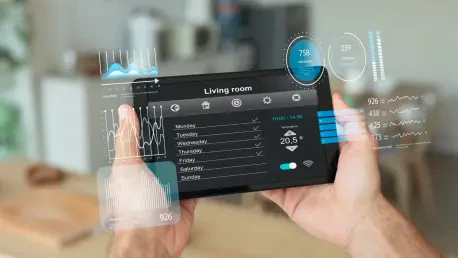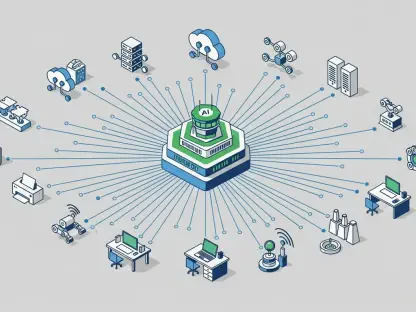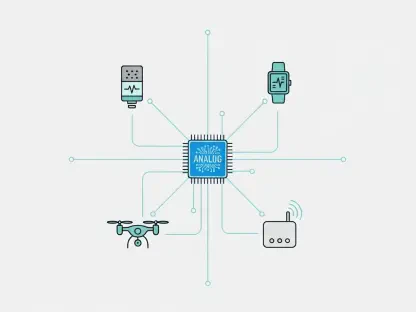Imagine managing an e-commerce platform that processes millions of transactions every minute, generating an overwhelming flood of telemetry data across countless microservices, including metrics, logs, and traces that pile up into terabytes daily. In such a high-stakes environment, when a critical incident strikes, on-call engineers are thrust into a nearly impossible task: sifting through this massive data deluge to pinpoint the root cause of disruptions. This challenge, often likened to finding a needle in a haystack, transforms observability from a potential asset into a source of frustration. However, emerging technologies offer a promising solution. By harnessing the power of artificial intelligence and structured protocols like the Model Context Protocol (MCP), it’s possible to turn raw data into actionable insights. This article explores the journey of building an AI-driven observability platform, delving into the architectural framework and sharing practical lessons learned from tackling these complex challenges head-on.
1. Unpacking the Observability Challenge
Modern software systems, especially those built on cloud-native and microservice architectures, rely heavily on observability to ensure reliability, performance, and user trust. The ability to measure and understand system behavior is fundamental, as the adage goes, “What cannot be measured cannot be improved.” Yet, achieving effective observability remains a significant hurdle. A single user request might traverse dozens of microservices, each producing logs, metrics, and traces. This results in staggering data volumes—tens of terabytes of logs daily, millions of metric data points, countless distributed traces, and thousands of correlation IDs generated every minute. The sheer scale of this telemetry data poses a daunting barrier to quick and effective incident resolution, often leaving teams overwhelmed by the task of making sense of it all.
Compounding the issue is the pervasive problem of data fragmentation. According to recent industry reports, half of organizations struggle with siloed telemetry data, and only a third manage to achieve a unified view across their metrics, logs, and traces. Without a consistent thread of context connecting these disparate data sources, engineers are forced to rely on manual correlation efforts. This process often depends on intuition, institutional knowledge, and painstaking detective work during high-pressure incidents. Such inefficiencies delay response times and heighten the risk of prolonged downtime, underscoring the urgent need for innovative approaches to streamline observability and transform raw data into meaningful, actionable insights for engineering teams.
2. Decoding the Model Context Protocol (MCP)
The Model Context Protocol, known as MCP, emerges as a vital tool in addressing observability challenges through its role as an open standard for secure, two-way connections between data sources and AI tools. This protocol facilitates a structured data pipeline that enhances how telemetry data is processed and understood. Key components of MCP include contextual ETL for AI, which standardizes the extraction of context from diverse data sources; a structured query interface that ensures AI queries can access data layers transparently and understandably; and semantic data enrichment, which embeds meaningful context directly into telemetry signals. Together, these elements create a robust framework for handling complex data interactions in modern systems, paving the way for more intelligent analysis.
By integrating MCP into observability practices, the shift from reactive problem-solving to proactive insight generation becomes feasible. This protocol allows platforms to move beyond merely responding to incidents after they occur, instead enabling systems to anticipate potential issues through enriched data. The ability to standardize and contextualize telemetry signals means that engineers and AI systems alike can access data that is intrinsically more meaningful. This transformation reduces the time spent on manual data correlation and enhances the accuracy of insights derived from logs, metrics, and traces, ultimately fostering a more efficient and forward-thinking approach to system management.
3. Exploring System Architecture and Data Flow
The architecture of an AI-powered observability platform built on MCP revolves around a layered design that systematically processes telemetry data for maximum utility. In the first layer, contextual telemetry data is developed by embedding standardized metadata into signals such as distributed traces, logs, and metrics. The second layer involves feeding this enriched data into an MCP server, which indexes and structures the information while providing client access through APIs. Finally, the third layer employs an AI-driven analysis engine that leverages the structured data for critical tasks like anomaly detection, signal correlation, and root-cause analysis, ensuring that issues within applications can be swiftly identified and addressed with precision.
This structured, multi-tiered approach delivers context-driven insights that are invaluable to both AI systems and engineering teams. By embedding context early in the data generation process, the system ensures that all telemetry signals are inherently linked, eliminating much of the guesswork during incident resolution. The MCP server’s role in organizing and providing access to this data further streamlines the process, while the AI engine’s analytical capabilities transform raw information into actionable recommendations. This cohesive architecture not only mitigates the challenges posed by data fragmentation but also empowers teams to maintain system reliability and performance in even the most complex cloud-native environments.
4. Diving into Implementation: A Three-Layer Approach
Implementing an MCP-powered observability platform requires a detailed focus on three distinct layers, starting with context-rich data generation. The primary objective here is to embed context into telemetry data at the point of creation rather than during analysis. This is achieved by incorporating correlation IDs and context dictionaries—such as user IDs and order IDs—directly into logs and traces. By ensuring that every telemetry signal carries consistent contextual data from the outset, the correlation challenge is addressed at its source. This foundational step eliminates the need for downstream manual efforts to piece together disparate data, setting the stage for more effective and automated analysis across the system.
The second layer centers on data access through an MCP server, transforming raw telemetry into a queryable API for streamlined interaction. Key operations in this phase include indexing for efficient lookups across contextual fields, filtering to isolate relevant data subsets, and aggregation to compute statistical measures over specific time windows. This structured interface converts an unstructured data lake into an organized, query-optimized system that AI tools can navigate with ease. Such transformation ensures that data retrieval is both fast and precise, enabling quicker identification of patterns or issues within the vast telemetry landscape that modern systems produce.
The final layer introduces an AI-driven analysis engine that consumes structured data via the MCP interface to perform advanced functions. This includes multi-dimensional analysis to correlate signals across logs, metrics, and traces; anomaly detection to identify statistical deviations from normal patterns; and root-cause determination to isolate likely sources of issues using contextual clues. By leveraging statistical methods like z-score calculations, the engine pinpoints anomalies and offers actionable recommendations. This layer ensures that insights derived are not only accurate but also directly applicable to resolving incidents, thereby enhancing overall system reliability and operational efficiency.
5. Advantages of MCP-Enhanced Observability
Integrating MCP into observability platforms yields significant benefits, particularly in speeding up anomaly detection and resolution. By embedding context early and structuring data for AI analysis, systems can drastically reduce the mean time to detect (MTTD) and mean time to resolve (MTTR) issues. Faster identification of irregularities means that potential disruptions are caught before they escalate, while quicker resolution times minimize downtime. This efficiency is critical for maintaining user trust and ensuring consistent performance in environments where every second of delay can impact customer experience or revenue streams, especially in high-transaction platforms like e-commerce.
Beyond speed, MCP-enhanced observability simplifies root-cause analysis and reduces operational noise. Identifying the source of a problem becomes more straightforward with context-rich data, as engineers no longer need to manually connect fragmented signals. Additionally, the system cuts down on unactionable alerts, alleviating alert fatigue among developers and boosting productivity. Fewer interruptions and context switches during incident resolution further enhance operational efficiency, allowing teams to focus on innovation rather than firefighting. These combined advantages create a more resilient and responsive system management framework, tailored to the demands of modern architectures.
6. Key Takeaways for Enhancing Observability Strategies
For teams looking to refine their observability strategies, embedding contextual metadata early in the telemetry generation process stands as a critical practice. By incorporating relevant identifiers and context at the source, downstream correlation becomes significantly easier and more accurate. This approach ensures that logs, metrics, and traces are inherently linked from the moment they are created, reducing the reliance on manual efforts during high-pressure incidents. Adopting this method can transform the way data is handled, making it a foundational step for any organization aiming to improve system monitoring and response capabilities in complex environments.
Another vital takeaway is the development of structured data interfaces through API-driven query layers. Creating accessible, query-optimized systems allows both human operators and AI tools to interact with telemetry data more effectively. Additionally, focusing AI analysis on context-rich data enhances the precision and relevance of insights, while continuous refinement of context enrichment and analytical methods based on real-world feedback ensures sustained improvement. These strategies collectively empower teams to move beyond traditional observability challenges, fostering proactive system management that anticipates issues before they impact performance or user experience.
7. Reflecting on the Power of AI and Structured Data
Looking back, the integration of structured data pipelines with AI proved to be a game-changer for observability in complex systems. By employing protocols like MCP alongside AI-driven analysis, vast amounts of telemetry data were transformed into actionable insights, shifting systems from reactive troubleshooting to proactive management. The essential pillars of observability—logs, metrics, and traces—were unified through this approach, eliminating the delays caused by manual correlation of disparate sources. This advancement marked a significant leap in how system health and performance were monitored and maintained across intricate architectures.
As a forward-looking consideration, it became clear that generating telemetry demanded structural overhauls alongside advanced analytical techniques to extract meaningful insights. Future efforts should focus on refining these data generation processes to embed even richer context at the source. Simultaneously, investing in scalable AI models capable of handling growing data volumes will be crucial. By prioritizing these areas, organizations can build observability frameworks that not only address current challenges but also adapt to evolving technological landscapes, ensuring long-term reliability and efficiency in system operations.









